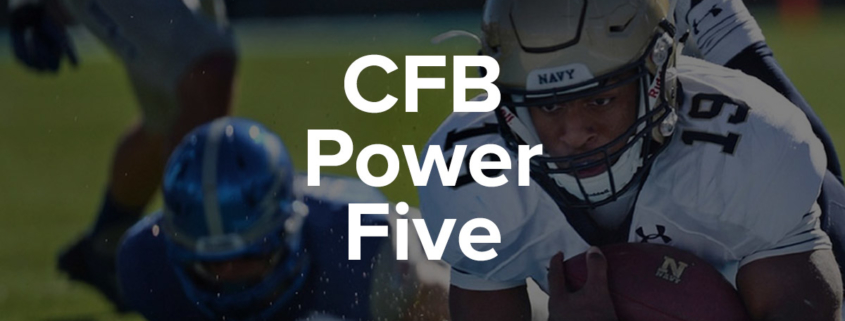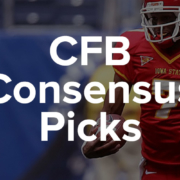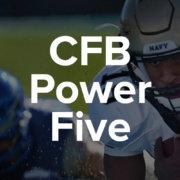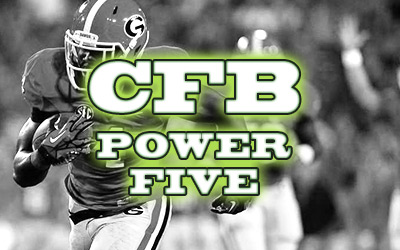I never thought this day would return.
I never thought I would be writing another Power Five or ever being able to play college football DFS.
But by golly, this mother f***** is baaaack!
The last time we could play college football on DraftKings, Jake Browning and Myles Gaskins were freshmen, Kyler Murray was a thing and my team, the Texas Tech Red Raiders had young gun Patrick Mahomes.
Now Mahomes is an NFL QB, Browning and Gaskins are seniors, trying to lead Washington to a college football player berth, and Kyler Murray will be the starting QB for Oklahoma, not Texas A&M.
Also, 2015, the last season of college football DFS was the first year of the College Football Playoff. Ohio State won the national title that year and now they are drowning in controversy surrounding its head coach, Urban Meyer.
My how the world changes.
But I have no complaints, the surprise reveal of CFB DFS was like believing in Santa Claus once again. I was so happy to receive this gift.
With its reappearance doesn’t come without change.
With the official Week 1 main slate on tap for Saturday, there are some different things for us to consider.
- No more mandatory 2 QB lineups.
- Instead, DraftKings added a Super Flex, where you can insert a QB, RB or WR.
- Tight ends are gone, too. You can play them, but you don’t have to. They are listed as WRs.
- Salaries are super tight. Unless you are confident in the value a game stack brings, it’s going to be tough to stack all of the top players from one game. For example, playing around with the Ole Miss-Tech game, it’s difficult to play all the RBs, both top-priced QBs and the top receiving options.
So I am not going to lie, figuring out the best strategy with the new lineup format may be a process moving forward. Ultimately, fielding the team with the players we like and feel is most optimal is the way we want to go. It you play 2 QBs, 4 RBs, or 4 WRs, scoring the most points possible is key. Duh, right?
And that leads me to my next point. There’s a huge edge in college football DFS. Not only will there be a lot of new players, there’s not an inundated amount of content out there specifically for college fantasy football. There are 130+ teams, lots of content to keep up with and injury news to follow.
But ultimately, it’s all about opportunity in college football. A $3K RB gets the start because of an injury? That’s pretty much lock city. Find a QB that runs a lot, throws a lot, scores lots of touchdowns? Lock city. Find a No. 1 receiver that gets the lions share of targets and receptions? Lock city.
College football is different than NFL. In college, talent and ability will overshadow and overcome matchups that lack talent. There’s less volatility and you can narrow down opportunity.
What you have to be careful of are blowouts. We will see that this weekend in a few matchups, specifically Clemson, TCU, Georgia and Missouri, all who take on FCS schools. There are other potential blowouts on this slate, like OU and FAU and Penn St. and Appalachian State, and Ohio State. But they are facing FBS schools at least, so you never know when a team like Appalachian State will sneak up on a Michigan, etc.
When blowouts occur, especially as the first half ends, starters will not come out and play in the second half. Teams in nonconference play won’t risk injury or exhaustion among its players for games they control and are out of hand in preparation for conference play.
Another tip for college football, where it is much like NFL, is finding games that will outkick its O/U line in Vegas. That’s what you want to shoot for.
I think I have provided a long enough intro, so it’s time to get down to business.
The format for the Power 5 is simple – 5 players at each of the 3 available skill positions for CFB DFS. I likely will tend to throw in a bonus play or two as well.
Until we are through with baseball season, this will be the format for my analysis, so be patient for a couple of weeks, then I will dive into the individual plays a bit more.
College football is back baby, and with it being Week 1, why not make this puppy free for this week only? Like what you see and your results, please subscribe to our monthly package and get other content like our College Football Consensus.
Good luck this week!
QUARTERBACKS
- Jarrett Stidham – Auburn – $7,800
- Trace McSorley – Penn State – $9,800
- Ross Bowers – Cal – $7,000
- Nathan Elliott – North Carolina – $7,600
- JT Daniels – USC – $8,700
Analysis: This first part is going to be a broken record – we are going to see a lot of teams roll out multiple QBs in Week 1. You will see this because of blowouts or because teams are rebuilding and looking to see who will take the starting role for the remainder of the season. You might hear a team name a starter before lock, like Texas Tech, but that doesn’t mean they will play all starting snaps. McLane Carter looks to be Tech’s starter, but there are talented guys behind him that could come into play should he struggle. That’s one example, so for this purpose, I wanted to focus on only guys we know will be the starter and not in a rotation. You will see that I like a lot of players from that Cal-UNC game. Teams scored a combine 65 points in that game and the O/U this year is at 61 with Cal favored by a touchdown. Cal and UNC have returning starters at this position. Jarrett Stidham is the big name prospect that gets the start against Washington. While it’s a tough matchup to open the season, Stidham gets the comfort of home to play through. McSorley returns for the Nittany Lions and they get Appalachian State, where they are favored by 23.5 points and a 54-point over/under. McSorley offers a massive floor. He never scored less than 19 DraftKings point last year, that is if CFB DFS existed. JT Daniels is the true wild card of the bunch, but he’s a young, dynamic starter that should have a stranglehold on the starting job for the Trojans. We are paying up some for someone unproven, but USC is at home and is a 25.5-point favorite against UNLV, where the O/U is 62.5 points.
RUNNING BACKS
- Nico Evans – Wyoming – $4,500
- Da’Leon Ward – Texas Tech – $5,400
- Patrick Laird – California – $8,900
- Rodney Anderson – Oklahoma – $9,700
- Antonio Williams – North Carolina – $4,600
Analysis: Again, the broken record, but this one is amplified. There are myriad of teams deploying running backs by committees. This list include guys that should either be the bellcow or a back that won’t share too many carries with his backup. But I want to start with Nico Evans. His pricing is baffling for me this year and I don’t see how the guy isn’t chalk. We had college football last Saturday in a 3-game slate. Evans was on that slate for Wyoming, he was $6,000 if my memory serves me well. What did he do in that game? Only 190 yards and two touchdowns. Wyoming has a solid defense and Washington State is not expected to be very good despite having the Mike Leach Air Raid offense behind them. Evans got 26 carries in that first game and if Wyoming handles a lead with its defense behind them, Evans should have himself another day. If they are behind, Evans should see some elevated target share in the passing game. That was a lot of words about a guy named Nico. So let’s go to Da’Leon Ward, the starter for Texas Tech despite some off-the-field issues. Tre King should see snaps, but he and Ward are going to control the touches out of the backfield. Ward is the cheap option with high-carry upside against a piss-poor Ole Miss defense. Patrick Laird and Rodney Anderson are the higher-priced fellas returning to their starting roles. Both have fantastic defensive matchups, especially Laird, who faces a UNC team that was nearly dead last in rushing yards allowed per game in 2017. There are some question marks despite the pedigree of Kyler Murray at QB for Oklahoma, so instead of overpaying for Murray, I will pay the fair price for a starting running back that should get a lot of carries in a blowout. Sure, he may not get all of the game snaps, but he’s likely going to be a good chunk of the reason for OU being ahead. Antonio Williams is the guy that is more of a wild card. UNC has some talented backs, but one should be out with an injury, leaving Williams, the Ohio State transfer with a chance to show his abilities. He’s super cheap and should see a fair amount of touches in what I like to be a high-scoring, close game.
WIDE RECEIVERS
- T.J. Vasher – Texas Tech – $9,400
- Vic Wharton III – California – $5,800
- David Sills V – West Virginia – $10,000
- Jajuan Jennings – Tennessee – $5,600
- Sal Cannella – Auburn – $3,000
Analysis: No matter who is throwing him the ball, I am going to be using T.J. Vasher in DFS all year long, and that might bite me in the ass, but the guy passes the eye test for me and I think he’s going to be a stud this season now that Keke Coutee is gone. At his price this week, and despite the matchup, I think Vasher goes vastly underowned in tournaments. The other big name I like this week is David Sills, a receiver with a massive TD ceiling, scoring 18 TDs last year on only 60 catches. What’s one more year going to mean for him? West Virginia is in a premier matchup against Tennessee where the Mountaineers are favored by 10 in a game that sports an O/U of 61.5 points. The remaining receivers are options for saving some salary. Wharton is a steady hand, in a game that I will be stacking multiple times over. Jennings is a high-quality talent that is underpriced and also in a game that could likely see lots of points scored. The minimum dart goes to Cannella, the starting slot receiver for Auburn, who got rave reviews in spring and fall camps. He’s min priced and Stidham may be needing some check downs against a salty Washington defense.







